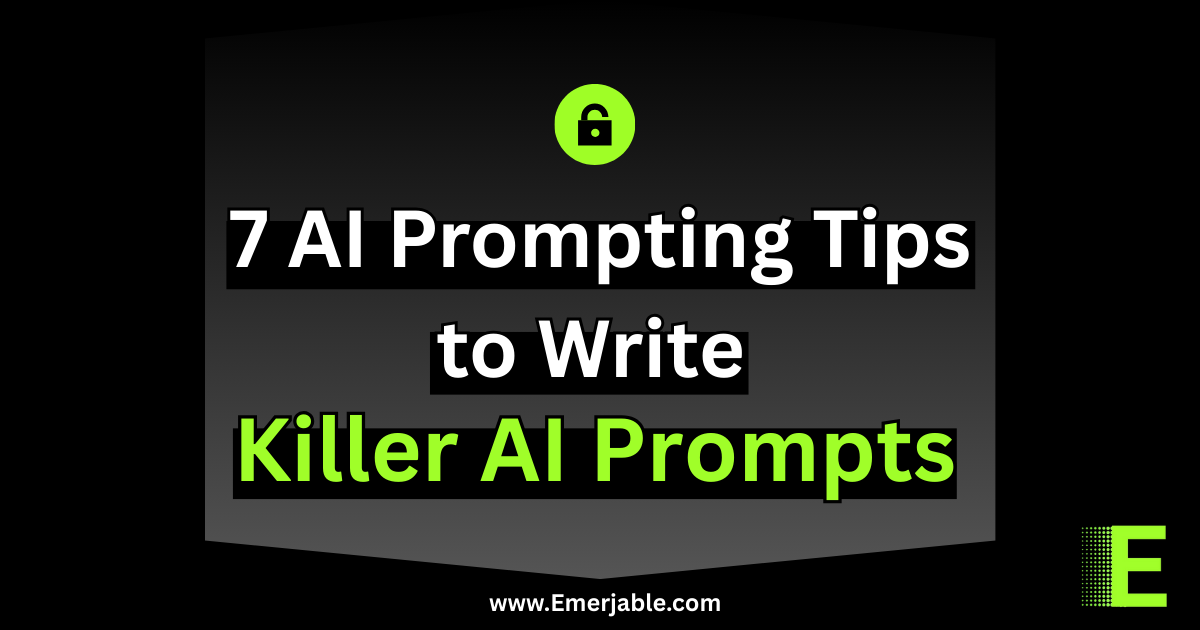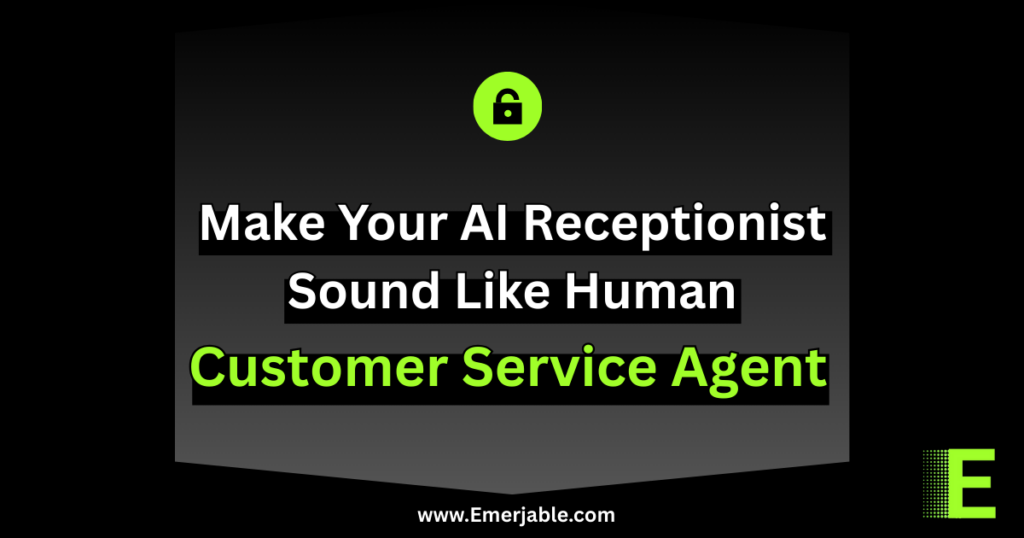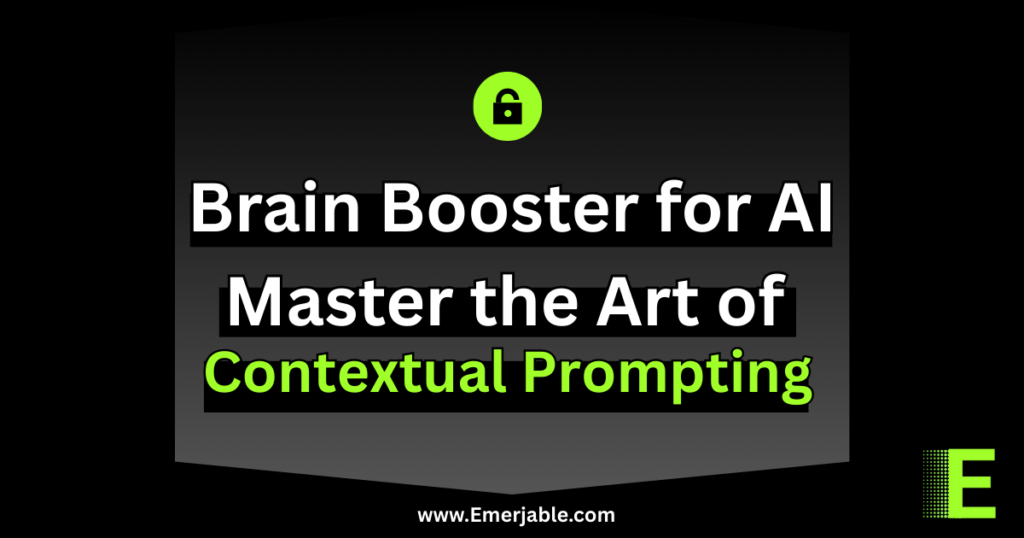If you’re using AI tools like ChatGPT, Claude, or Gemini, you’ve probably wondered: How do I get better results? The answer lies in your prompts—the instructions you give the AI. Writing great prompts is like giving the AI a GPS—it needs clear directions to deliver exactly what you want.
In this article, you’ll learn 7 powerful AI prompting tips to write better AI prompts. Whether you’re a beginner or just looking to improve, these tips will help you get more accurate, engaging, and useful responses from any AI model.
✅ 1. Be Crystal Clear and Specific
One of the most common mistakes beginners make is being too vague.
How to fix it:
- State your goal directly
✅ Example: “Summarize this article in 3 bullet points.” - Include context
Tell the AI what it’s about, who it’s for, and why it matters.
✅ Example: “This is for a business owner who knows nothing about SEO.” - Mention the format
✅ Example: “Write this as a list of pros and cons.” - Define the audience
✅ Example: “Explain it in simple terms for high school students.”
🧠 2. Guide the AI’s Thinking Process
Think of AI like a smart assistant. It’s powerful, but it still needs step-by-step instructions.
How to guide:
- Break tasks into smaller parts
✅ Example: “First, give a summary. Then suggest a title. Then list keywords.” - Ask open-ended questions
✅ Use “how,” “why,” and “what if” instead of “yes/no.” - Provide examples
✅ Example: “Here’s an example format: Introduction → Benefits → CTA.” - Give limits or restrictions
✅ Example: “Don’t use technical jargon. Keep sentences under 15 words.” - Use relevant keywords
Include niche-specific terms to help AI understand your goal.
🔄 3. Refine and Iterate
Your first prompt might not be perfect—and that’s okay.
Make it better by:
- Starting with a simple version and improving it step-by-step
- Rephrasing if the response isn’t what you expected
- Experimenting with different instructions and angles
- Tweaking parameters like creativity (in tools that allow it)
- Asking follow-up questions to dig deeper
🎯 4. Use the Right Tone and Style
AI can write in many voices—from formal reports to fun Instagram captions.
Tips:
- Specify the tone you want
✅ Example: “Write in a friendly and casual tone.” - Request a writing style
✅ Example: “Write like a travel blog article” or “in the style of Steve Jobs.” - Mention the mood
✅ Example: “Make it motivational and inspiring.”
🚀 5. Play to AI’s Strengths
AI is great at some tasks. Use those strengths to save time and boost creativity.
Top use cases:
- Brainstorming ideas
Blog topics, product names, video scripts, etc. - Explaining difficult topics simply
Use it as a mini tutor. - Summarizing long content
Speed through research or book notes. - Creative writing
Short stories, poems, ads, and social captions.
🛠️ 6. Give It a Role or Persona
AI performs better when it knows who it’s pretending to be.
Try this:
- “Act as a professional copywriter.”
- “You are now a UX expert.”
- “Pretend you’re an email marketing consultant.”
This sets the tone and perspective for the AI’s response—and leads to more accurate results.
📈 7. Test, Learn, and Save Winning Prompts
Prompting is a skill—so treat it like one.
Best practices:
- Save your best prompts for reuse
- Create prompt templates for common tasks
- Compare results from different versions
- Document what works and what doesn’t
Over time, you’ll build your own library of high-converting, effective AI prompts.
Mastering Effective LLM Prompts for AI Text Generation
🎁 Bonus Tip: Use Prompting Tools
There are tools to help you build, refine, and test prompts like a pro:
- PromptPerfect – optimizes your prompt wording
- AIPRM for ChatGPT – ready-to-use prompt templates
- FlowGPT – a prompt sharing marketplace
- Notion AI + Templates – store and test your best prompts
🔥 Top AI Prompt Use Cases with Example Prompts
💼 1. Blog Writing & Content Marketing
Use Case: Generate SEO blog posts, product reviews, or thought leadership content.
Prompt Example:
“Write a 1000-word blog post on ‘Top 10 Budget Travel Tips for Europe’ in a friendly, conversational tone. Include an engaging intro, a numbered list, and a conclusion with a CTA to subscribe.”
✅ Pro Tip: Mention audience (travelers), tone (casual), format (numbered list), and goal (newsletter sign-up).
🛒 2. Product Descriptions for E-Commerce
Use Case: Create compelling product copy that sells.
Prompt Example:
“Write a high-converting product description for a wireless noise-cancelling headphone under $100. Highlight 3 key features, include a customer benefit for each, and end with a persuasive CTA.”
✅ Pro Tip: Be clear about tone (persuasive), price point, and product benefits.
📧 3. Email Campaigns
Use Case: Craft welcome emails, follow-ups, or newsletters.
Prompt Example:
“Create a friendly welcome email for new users who signed up for a fitness tracking app. Include a warm greeting, a quick overview of features, and a motivational sign-off.”
✅ Pro Tip: Mention the product purpose and emotional tone (motivational).
🧠 4. Summarizing Long Documents
Use Case: Quickly condense reports, research, or articles.
Prompt Example:
“Summarize this 10-page report into 5 key bullet points in plain English for a non-technical audience.”
✅ Pro Tip: Define output format (bullets) and target audience (non-technical).
📝 5. Creative Writing / Storytelling
Use Case: Write short stories, poems, or character-driven scenes.
Prompt Example:
“Write a short story about a lonely astronaut who discovers an alien civilization. Keep it under 300 words, use a poetic tone, and add a twist ending.”
✅ Pro Tip: Guide tone, genre, length, and desired twist.
📱 6. Social Media Captions & Content
Use Case: Create engaging posts for Instagram, LinkedIn, or Twitter.
Prompt Example:
“Write 3 witty and engaging Instagram captions for a brand launching a new eco-friendly water bottle. Each should be under 150 characters and include a relevant hashtag.”
✅ Pro Tip: Mention platform, tone (witty), and content constraints (character count).
🎓 7. Explaining Complex Topics Simply
Use Case: Turn expert-level content into layman-friendly explanations.
Prompt Example:
“Explain the concept of blockchain to a 10-year-old using a story about trading cards.”
✅ Pro Tip: Define the complexity level and use analogies or metaphors.
📊 8. Resume or LinkedIn Profile Optimization
Use Case: Improve professional branding with AI.
Prompt Example:
“Rewrite this LinkedIn bio to sound more dynamic and achievement-oriented for a senior marketing manager looking to pivot into tech startups.”
✅ Pro Tip: Mention the current industry, new industry, and desired tone.
📖 9. Course or Training Material Creation
Use Case: Build lesson plans, micro-courses, or instructional content.
Prompt Example:
“Create a beginner-friendly 5-step guide to setting up a WordPress blog. Include actionable tips and tools for each step.”
✅ Pro Tip: Structure matters—ask for steps, modules, or lists.
🛠️ 10. Brainstorming Ideas
Use Case: Generate names, hooks, or topics quickly.
Prompt Example:
“Give me 10 unique YouTube channel name ideas for a tech review channel that focuses on budget gadgets.”
✅ Pro Tip: Be clear on your niche and audience.
🧩 Bonus Prompt Tip: Combine Roles + Context
“Act as a professional brand strategist. I’m launching a wellness drink for busy professionals. Suggest 5 tagline options that emphasize focus and mental clarity.”
✅ Combining a persona (brand strategist) + product context = much sharper output!
Final Thoughts
Mastering the art of prompting isn’t just for developers or data scientists. Whether you’re a marketer, entrepreneur, student, or creator, these simple tips can help you get better results, save time, and unlock creativity.
Start applying these 7 AI prompting tips today, and watch your AI content become more engaging, more accurate, and more valuable.
Want to Go Deeper?
Explore more on:
- Advanced LLM Prompt Engineering Techniques Level Up Your AI Prompts
- The Ultimate Guide to LLM Prompting
- What Exactly Are AI Prompts? A Simple Explanation for Everyone
- Understanding the Basic Structure of Effective LLM Prompts
- LLM Prompts for Beginners: Your First Steps to AI Text Generation
- The Secret to Writing Effective LLM Prompts for Engaging Blog Posts
- Boost Your Social Media: Proven LLM Prompts for High-Impact Content
- Crafting Compelling Emails with AI: Effective LLM Prompt Strategies
- Unleash Your Creativity: Mastering LLM Prompts for Story Writing
- Generate High-Converting Product Descriptions with These LLM Prompts
- LLM Prompts That Actually Work for Summarizing Long Documents
- Prompt Refinement Techniques & The Power of Iteration
- Mastering Contextual Prompting: Giving Your AI Context & Brain
- Advanced Strategies for Controlling LLM Output with Prompts: Fine-Tuning Your AI
- How to Prompt an AI Receptionist Like a Pro: AI Receptionist Prompting



